Pride in the hide Fibre artist salvages sheep skin destined for destruction, transforming the ’byproduct’ into finely crafted textiles using traditional bark-tanning methods
Read this article for free:
or
Already have an account? Log in here »
To continue reading, please subscribe:
Monthly Digital Subscription
$1 per week for 24 weeks*
- Enjoy unlimited reading on winnipegfreepress.com
- Read the E-Edition, our digital replica newspaper
- Access News Break, our award-winning app
- Play interactive puzzles
*Billed as $4.00 plus GST every four weeks. After 24 weeks, price increases to the regular rate of $19.00 plus GST every four weeks. Offer available to new and qualified returning subscribers only. Cancel any time.
Monthly Digital Subscription
$4.75/week*
- Enjoy unlimited reading on winnipegfreepress.com
- Read the E-Edition, our digital replica newspaper
- Access News Break, our award-winning app
- Play interactive puzzles
*Billed as $19 plus GST every four weeks. Cancel any time.
To continue reading, please subscribe:
Add Free Press access to your Brandon Sun subscription for only an additional
$1 for the first 4 weeks*
*Your next subscription payment will increase by $1.00 and you will be charged $16.99 plus GST for four weeks. After four weeks, your payment will increase to $23.99 plus GST every four weeks.
Read unlimited articles for free today:
or
Already have an account? Log in here »
RM of ARMSTRONG — There comes a point in a person’s life when they find themselves contemplating the trajectory of their journey.
For LeVerne Tucker, 63, that moment came one October afternoon.
Gazing around her surroundings, Tucker pondered the choices she’d made that led her to wait behind an abattoir for her prize to arrive — a waste receptacle containing sheep byproducts.
Gloved to the elbows, legs and body sheathed in a black rubber apron and matching boots, she plunged her bright-yellow rubber-gloved hands into the plastic bucket, emerging with skins from sheep butchered for meat, their hides discarded, either to be incinerated or composted.
She worked swiftly to transfer the hides into her own containers in the trunk of her car to be transported to her one-woman farm in the Interlake region.
The job is raw and messy; the skins are matted with blood and feces.
“At that point I’m thinking, ‘what’s happened to me, pulling bloody hides out of a bucket and putting them nicely in my vehicle. Is this who I am? Am I in my dark era now?’” she says, laughing.
The skins are soaked for a day before starting multiple cycles of rinsing and washing, which are all done by hand.
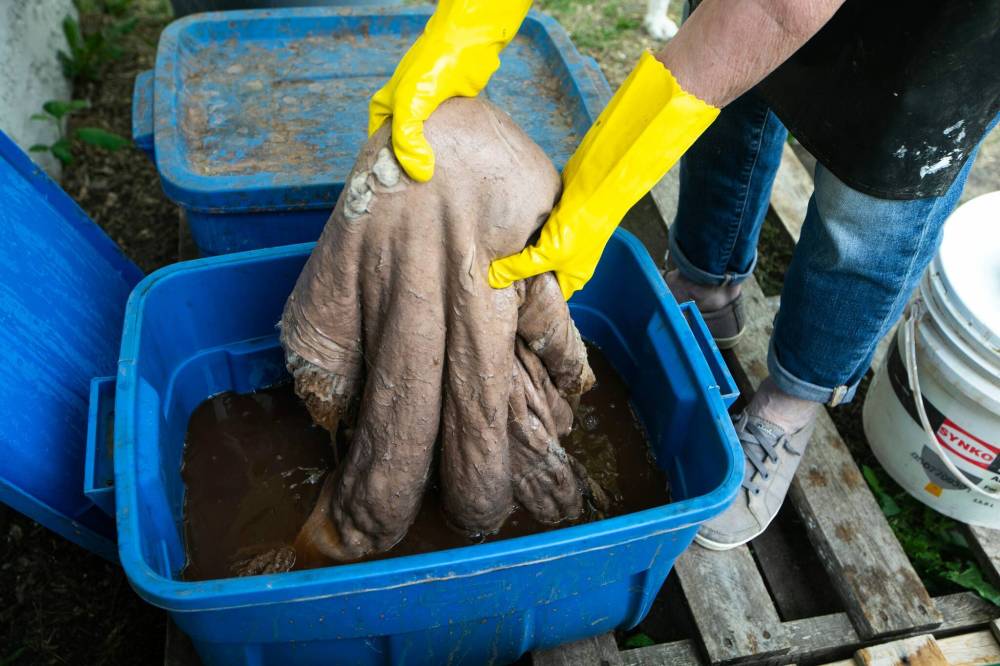
These are not unreasonable reflections. People don’t often drive to abattoirs to pick up remains of dead animals.
But Tucker is cut from a different cloth.
Considered and considerate, thoughtful and quietly passionate, Tucker is the kind of person who, when they see something they don’t like, decides, with no fuss nor fanfare, to change the status quo.
The woman with a freezer “big enough to hold a body” — her words, not ours — who lives on her farm, The Last Dance Ranch, spends her time collecting the bloody skin of dead animals.
Her choices may seem macabre to some and her humour is as black as the garbage bags in which she stores her skins.
LeVerne Tucker blames her genuine love of textiles for “opening up a can of worms.”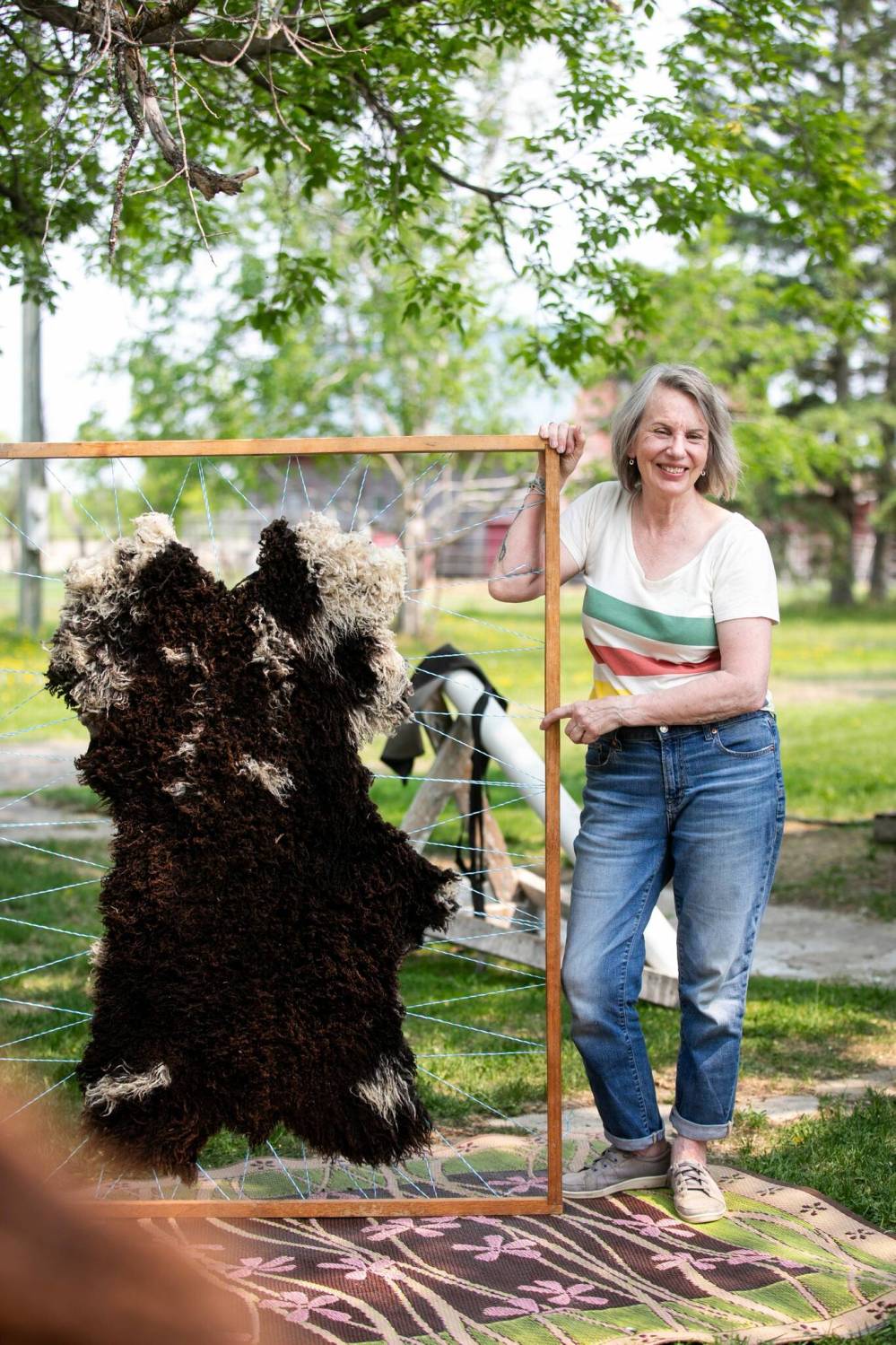
“I am not some weird lady after your livestock remains,” she laughs. “I simply salvage animal hides that would otherwise be added to the agricultural and food-waste stream.”
The textile artist recovers sheep hides destined to be destroyed, transforming them into beautiful sheepskins using traditional bark-tanning methods.
It’s a job that takes days and weeks of work which, fortunately for Tucker — who does this alone while managing her arthritic pain — can be executed in stages.
She blames her genuine love of textiles for “opening up a can of worms.”
“As far as I know I am the only person doing it here,” she says.
“Well, who wants to throw things in the garbage? And that’s essentially where they were ending up… in the garbage. I am an artist before I am a farmer… I see beauty in it. It’s a different perspective.”
It’s not necessarily an uncomfortable perspective, just one that may not rest in many other people’s minds.
There are 22 provincially licensed abattoirs in Manitoba that process livestock ranging from cattle and bison to chicken and hogs. Of those, 12 “harvest” sheep and lamb. Last year 5,385 ovines were butchered at these facilities.
Bred for meat and shorn for wool, almost all sheepskins, categorized as animal byproducts, are destroyed.
It’s the consequence of living in a society where meat consumption is culturally ingrained.
Manitoba Agriculture does not have a specific policy regarding animal waste, a provincial spokesperson said. Instead, it is up to each facility to decide what to do with the skins.
A survey of a half-dozen abattoirs shed little light on the issue — farmers can request hides to be salvaged, but if they don’t, the animal skins are destroyed.
Tucker has no expectations for the agriculture industry to monitor every single aspect of butchery.
As she pithily puts it, “you don’t kill cows for shoes, and sheep aren’t processed for sheepskins, they’re processed to feed people. There is no shame in it.”
But it bothers her that the entirety of an animal, sacrificed to fill freezers, is not being used.
Tucker's endgame is to preserve a sustainable resource rather than establish an industry.
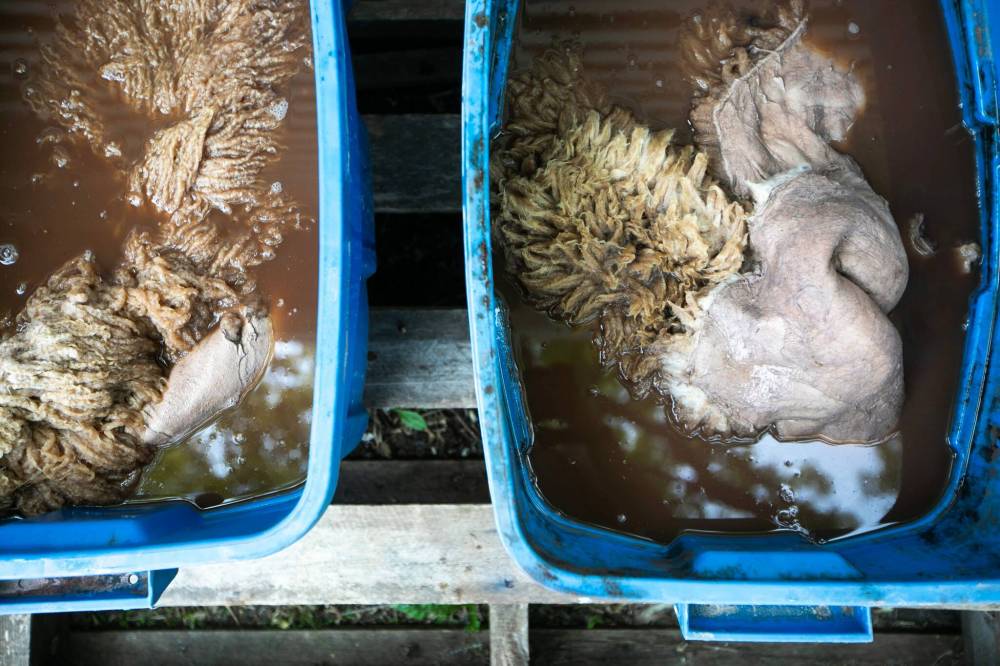
“My actions are a way to honour the animal’s existence, to use more of it by creating heirloom textiles that can be left behind, passed down through generations when everyone has eaten, when everything is empty again,” she says.
“If there is something left over from an animal that has fed people, I would like to do something with it. It’s about keeping more than bellies full.”
Tucker’s foray into hide retrieval and sheepskin prep came about after a conversation with a fellow farmer.
Her love of wool and sheep sparked a question: What happens to the skin after the animal is butchered?
“I was taken aback when I heard the skins would be burned. Before this I never thought about what happens to the skin. I mean, you see sheepskins in the stores, you see leather and cowhide rugs, so I assumed it just got used, but in truth, a lot of it goes into the dumpster,” she says.
What started out as a personal goal to remove hides from the waste stream has now grown beyond Tucker's imagination.
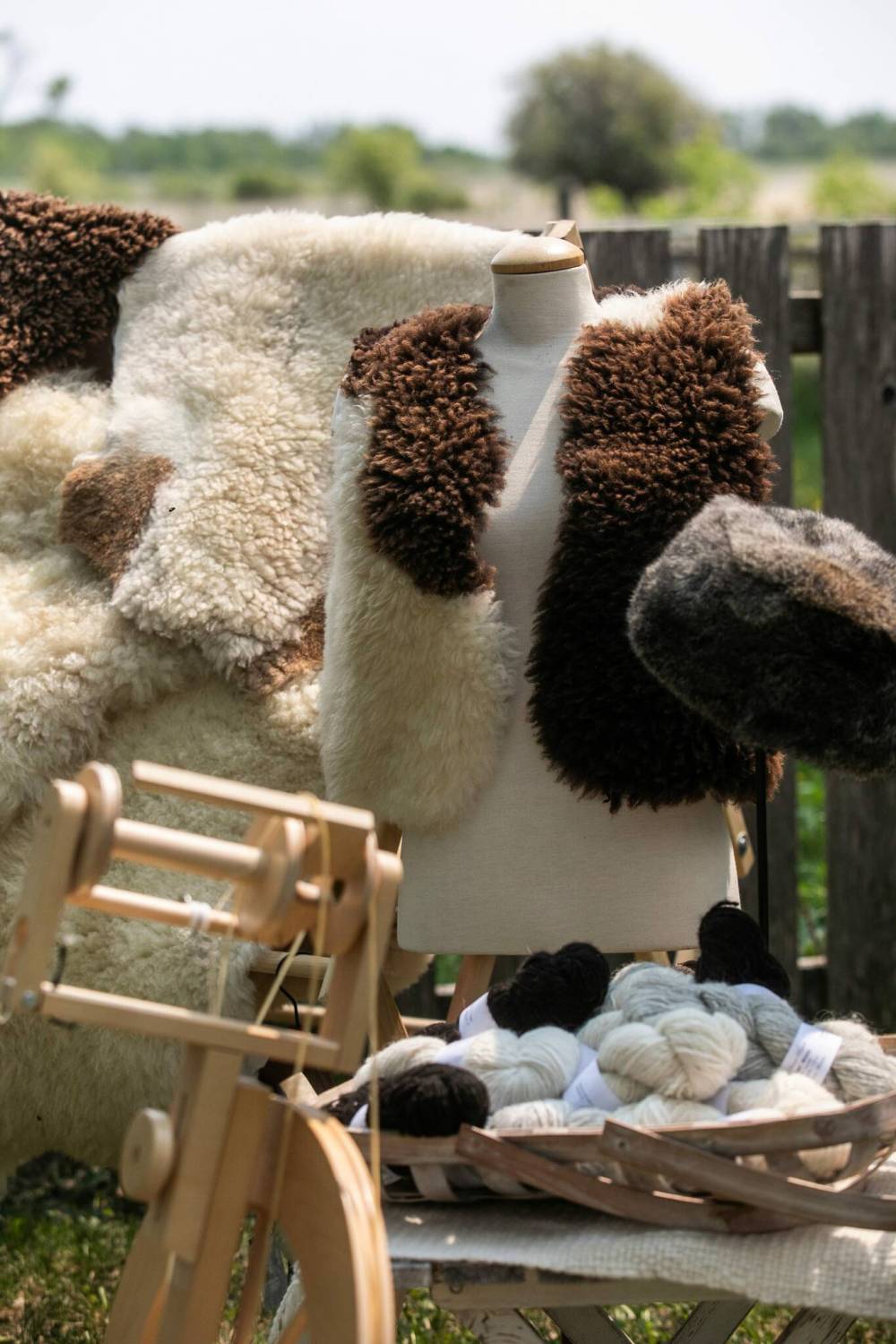
It took some time for her to digest the information; she’d never considered that aspect of the agriculture waste stream. After mulling it over, she asked if she could have them instead.
What started out as a personal goal to remove hides from the waste stream has now grown beyond her imagination.
Last year she salvaged more than 70 sheep hides, working with farmers and butchers to recover skins.
News of her endeavours reached the ears of local hunters who proceeded to bring her deer and rabbit hides, too. In 2024, she collected a total of 104 sheep, goat, deer and rabbit hides and tanned them all herself.
“It’s not even the top of the waste-stream iceberg, but it makes use of something that would ultimately go into the garbage. And I have a lot of peace with that,” she says.
She expects to salvage the same number of hides this year, and has already been gifted four deer and a dozen rabbit skins. The sheepskin won’t come until September when farmers typically harvest the meat.
Her endgame is to preserve a sustainable resource rather than establish an industry.
“This is small-batch stuff, this is not going to be mass-produced. It is original, it is completely local, it is sustainable. And for people who live in Winnipeg, well, it’s from your own backyard, from Manitoba’s Interlake, from neighbouring towns,” she says.
Humans have repurposed animal skins for eons to clothe bodies, shoe feet and carry things. Before tanning methods were discovered, the untreated skins would eventually rot or become stiff and hard, and thus rendered useless.
Considered one of the earliest forms of trade, tanning — using either fat, plant matter or minerals to preserve raw hides — can be traced back to the early Stone Age.
One method, using fatty substances such as the brain of the animal itself, is thought to have originated around 8,000 BCE.
“Skins tanned with egg and oil (fat) are then smoked to preserve the hide. The egg and oil are substitutes for the method known as brain-tanning, which uses the animal’s brain (matter) to tan the hide. I don’t do that; the thought makes me a bit queasy,” Tucker says.
LeVerne Tucker views her tanning work as means to honour an animal’s existence by transforming sheepskin that otherwise would be discarded during the butchering process into well-crafted, heirloom textiles.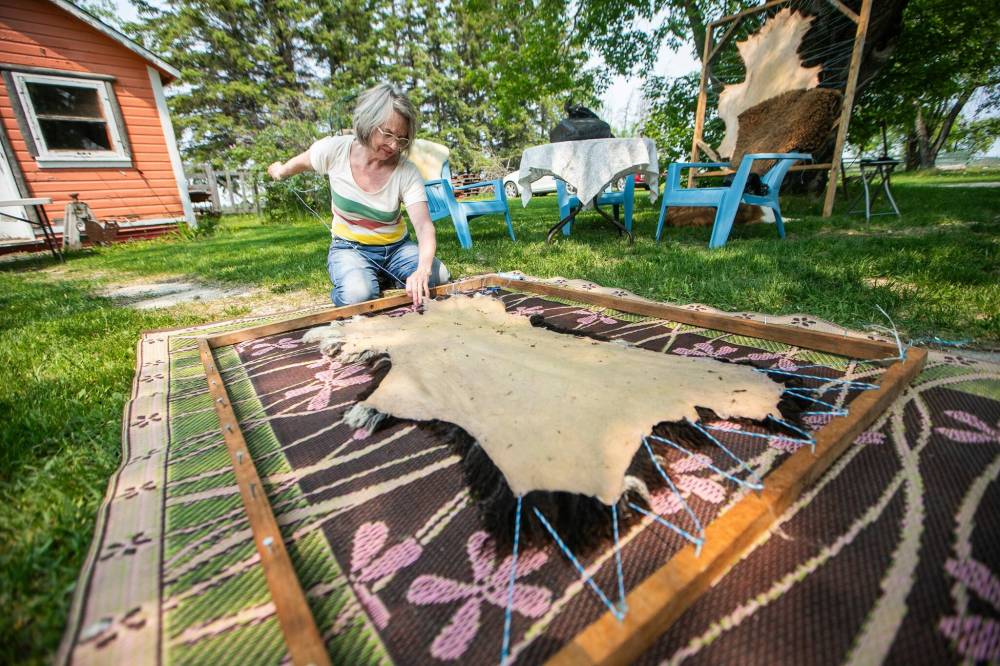
Five thousand years later the Egyptians and Mesopotamians used the natural tannins in tree bark to preserve hides.
It’s the method Tucker employs, yielding hides that are completely chemical-free.
“If left in the woods they would compost right back into nature over time,” she says.
Tanning is back-breaking work, but it’s a labour of love for Tucker.
“The reason I am able to do this at all is because I do it in snippets every day. I have physical limitations because of my arthritis and fatigue, and hide-tanning can be done in small parts,” she says.
“Within the 10 days it takes to tan a hide, there might be one hard day, but even then I am able to take a break and sit down.”
Actual tanning takes place later in the process. Her first task is to prepare the hides. Lugging the bins full of skins from her trunk, she scrapes each one by hand on a fleshing beam constructed from two-by-fours and PVC piping.
Tucker's method yields hides that are completely chemical-free.
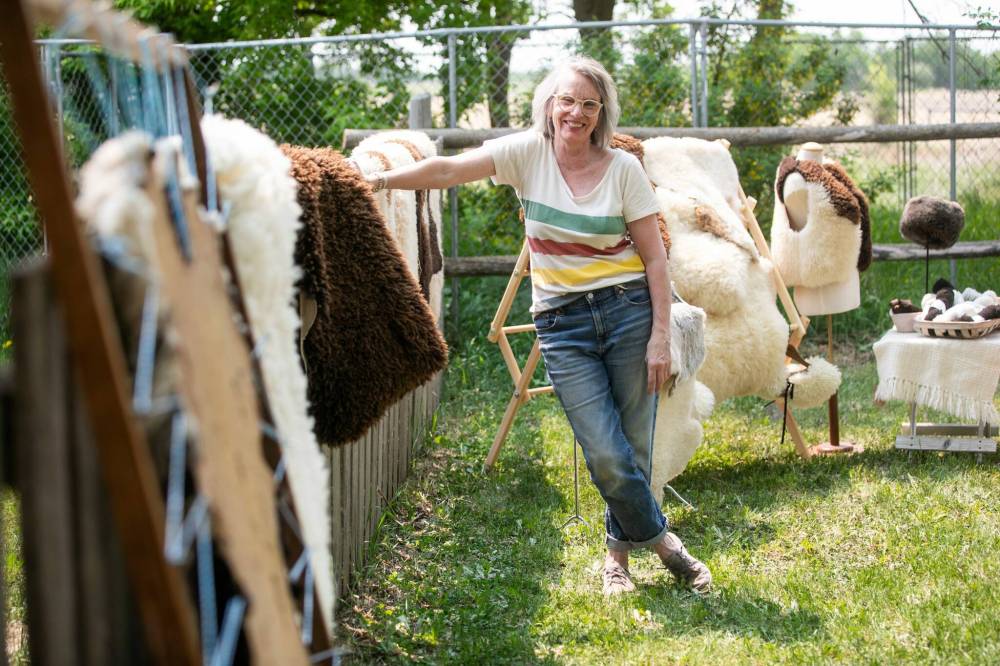
She removes any remaining flesh and fat that will cause the skin to rot. Then the hide is laid out flat and salted liberally with plain white salt before being left for 24 hours. The next day, the now-moist salt is shaken off, before the hide is re-salted.
It can take anywhere from three days to a week for the salt to do its work to remove all traces of moisture.
When the hides are completely dry, Tucker places them in black garbage bags in which they can be stored for up to a year in her basement.
Once the weather warms up, she starts the tanning process outdoors.
“I can start outside by April and work until the end of October. I just have to bring stuff in at night,” she says.
It’s a far sight from where the bloodied hides were retrieved to where Tucker presently lives on a charming seven-acre farm, The Last Dance Ranch, which she shares with 20 chickens, eight sheep, four cats, two horses, three dogs and Marigold, the miniature Mediterranean donkey.
A gentle breeze rustles the leaves of her maple tree, the bucolic scene awash in summer sunshine as she opens plastic bins to reveal black garbage bags filled with hides she salted last fall.
Tucker shares her seven-acre farm with numerous animals, including eight sheep.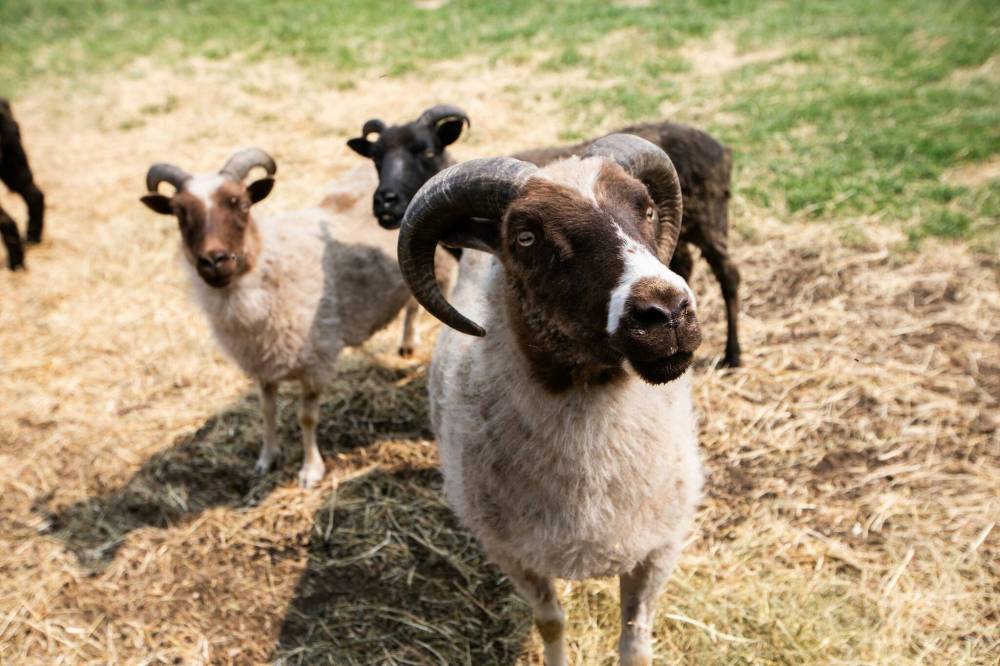
Each meticulously tagged bag has information on the provenance, date obtained, staple length (length of individual wool fibres), and condition of the hide, so she can make a quick decision on what she wants to work on without having to open each bag.
The skin smells, quite frankly, of meat. And while it has been scraped, signs of dried blood still remain. There’s no escaping the fact this was once on a living, breathing creature.
Tucker’s hides mostly come from Suffolk, Île-de-France, Rideau Arcott, Katahdin and Dorper breeds of sheep, sourced from farms run by people she’s come to know through the years — like Meaghan Lomax from Wildfire Farms, Randy Eros of Seine River Shepherds and Sophia and Nolan Kroeker from JL Kroeker Farms.
“It’s all about relationships and trust. Otherwise this endeavour simply wouldn’t work, because if you just phoned a butcher and said, ‘hey, can I have some raw hides’ they won’t even bother with you.
“Butchers work for speed, not for intact hides. So the hides come off in whatever manner they come off, but if they are requested — if the farmer they’re dealing with says, ‘I’d like you to meet this person, and she would like to do this’ — then the hides come in one congruent piece,” she explains.
LeVerne Tucker works in the barn on her property, The Last Dance Ranch, near Teulon. She has now been running the farm for 11 years.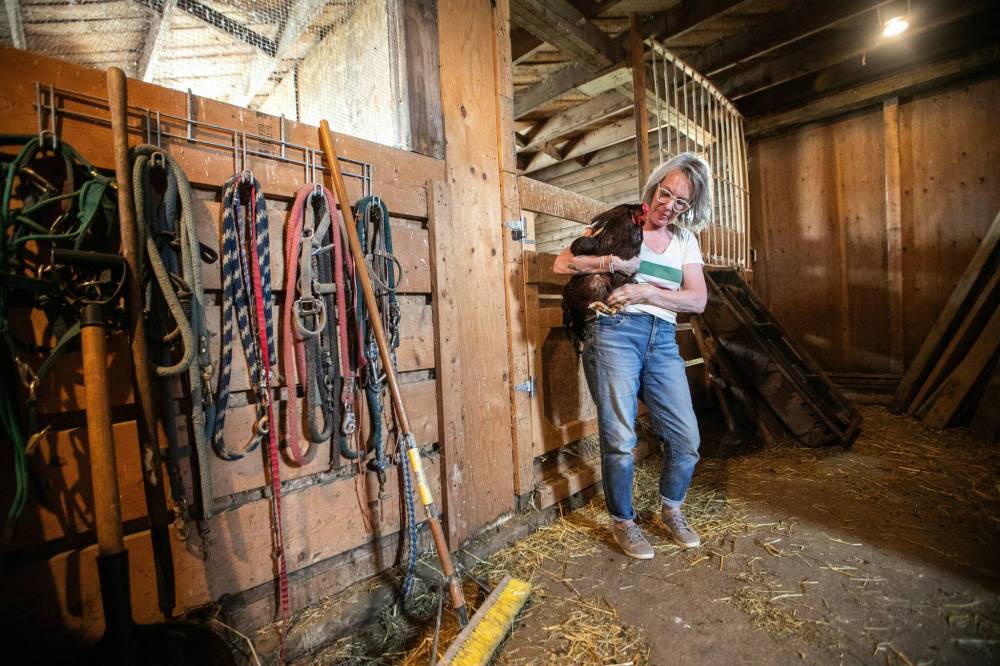
These conversations have afforded her the opportunity to build a relationship with the butchers and ensure her hides come to her with fewer rips and holes.
“A couple of the butchers are fairly good sports, so when I say I want to come and pick up those 22 hides from Seine River Shepherds or from Wildfire Farms or from JL Kroeker Farms, they will take a little bit of time and try and do them with less holes for me,” she continues.
Not that she’d let something like a hole or a rip stand in her way. Instead she cuts around them, rescuing as much of the hide as she is able to, so she can fashion sheepskin collars, hats and vests. She’s also been known to stitch larger rips; it’s one of her “compulsions.”
“I don’t want to waste any bit of it. If you plan it properly you can take just 20 minutes to sew it up. Just because it has a hole in it doesn’t mean it has to be garbage,” she says.
Preparing raw, salted hides for tanning is not for the faint-hearted.
The long and laborious process involves soaking the skins for a day before starting multiple cycles of rinsing and washing, which are all done by hand.
The skins are then placed in a tub of citric acid and salt topped with water (“It’s essentially a pickle”) and left to sit with the lid on for three days before tanning begins.
Tucker makes a mixture of powdered bark tannin and water, into which she places the hides, where they will remain for a week to 10 days. She sloshes and stirs the hides intermittently to ensure an even tanning process.
When fully tanned — “the entire thing has to be a beige colour” — it’s time for yet another rinse. They are then drip-dried to a specific stage “where they take on the texture of a squishy sponge: wet but not dripping with water.”
It takes about 10 days to tan a hide, but Tucker
first must scrape the raw skins and dry them.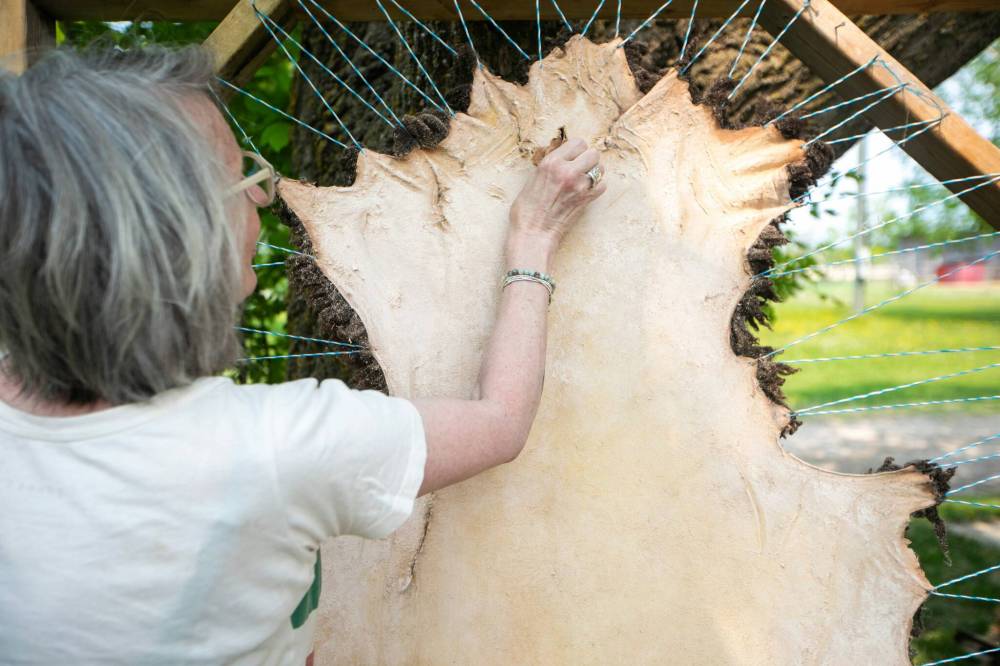
She then applies a permanent dressing made from a mixture of egg yolk, oil and water to the skin side which, much like moisturizer, is absorbed into the hide, keeping it soft and malleable.
Drying involves stringing the hides up with twine onto large wooden frames.
At this time of year, it takes 24 hours for a hide to dry outdoors in the shade.
The back of the sheepskin is then smoothed down gently with a pumice stone before Tucker finally releases it from the frame, using her late father’s old hunting knife to cut around the holes through which the twine is strung.
The whole piece comes apart neatly — the culmination of work which started late last fall, the results only apparent months later.
At this time of year, it takes 24 hours for a hide to dry outdoors in the shade.
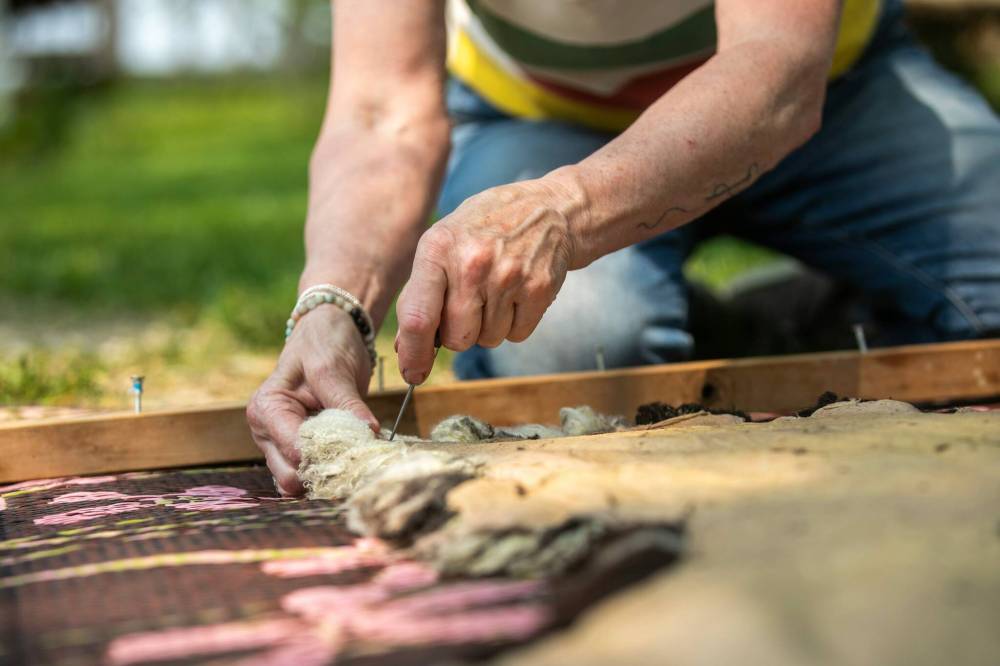
The hides, now soft and luxurious, are ready to be transported to the St. Norbert Farmers’ Market where she has a stand most Saturdays in the summer. She also lists pieces on her Instagram (instagram.com/thelastdanceranch) where they are swiftly snapped up by people in search of everything from chair coverings and baby swaddles, to collars, hats and her latest offering, sheepskin pinch purses.
She was recently offered a bison hide but has yet to decide if she wants to take it on, as she’s about to embark on goat tanning, after meeting Kishon Warrington of BacktoRoots Farm, a family-run establishment in the RM of St. Clements.
Tucker is the first to admit she did not know what she was getting herself into when she embarked on her hide-salvaging scheme. But she has no regrets.
“When I lived in the city, I would have been horrified by what I am doing now. But I’ve evolved a lot since living out here. It’s changed me. And as I keep learning more about it, I want to learn even more,” she says.
She’s been running her farm for 11 years but still doesn’t consider herself a farmer.
Tucker operates a vintage loom to weave tea towels.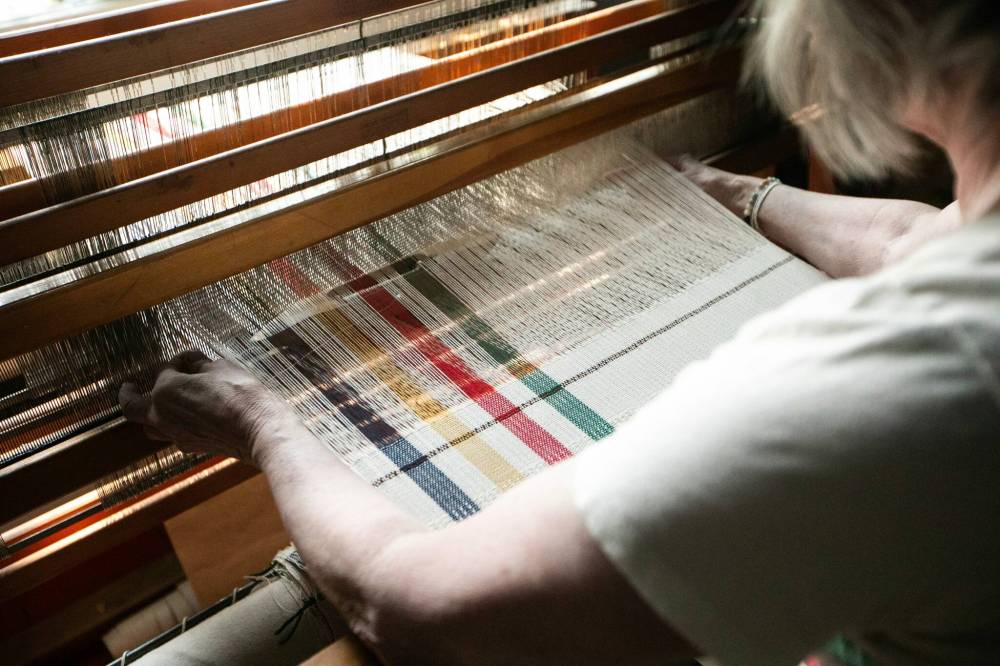
The artist learned to weave and spin, and began processing her own wool from her flock of eight Icelandic sheep.
When she’s not tanning her hides she’s using her hand-spun yarn as well as other natural fibres such as cotton and silk to weave textiles on her vintage Leclerc looms.
“Loosely speaking, I would be an artist that grows their own art supplies, rather than a farmer in the traditional sense of the word. Am I a productive farmer? No, but I am a happy one,” she says, smiling.
av.kitching@freepress.mb.ca

AV Kitching is an arts and life writer at the Free Press. She has been a journalist for more than two decades and has worked across three continents writing about people, travel, food, and fashion. Read more about AV.
Every piece of reporting AV produces is reviewed by an editing team before it is posted online or published in print — part of the Free Press‘s tradition, since 1872, of producing reliable independent journalism. Read more about Free Press’s history and mandate, and learn how our newsroom operates.
Our newsroom depends on a growing audience of readers to power our journalism. If you are not a paid reader, please consider becoming a subscriber.
Our newsroom depends on its audience of readers to power our journalism. Thank you for your support.
